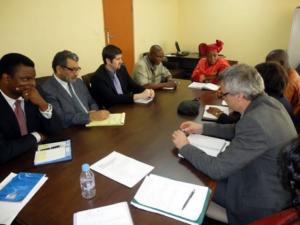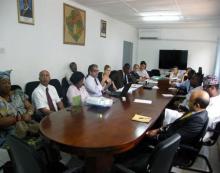Sierra Leone WHO Country Office Newsletter January-February 2012
In this Issue
1. Harmonization of Partners Financial Arrangement
2. Assessment of Nutrition Interventions in the Western Area
3. Launch of a Partnership for Safe Medicines Initiative
_______________________________________________________________________
Harmonization and Alignment of Development Partners Financial Management Arrangements
Background
The Health Systems Funding Platform (the Platform) was established in 2009 on the recommendation of the High Level Taskforce on Innovative International Financing for Health Systems. It was established as a mechanism, to coordinate, mobilize, streamline and channel the flow of existing and new resources to support national health strategies and further progress in achieving the Millennium Development Goals (MDGs).
The Platform was initially developed by the Global Alliance for Vaccination and Immunization (GAVI), the Global Fund (GF) and the World Bank (WB), in consultation with other key stakeholders, including civil society and facilitated by the World Health Organization (WHO). It is in line with the Paris Declaration on Aid Effectiveness to promote: national ownership, alignment with national systems, harmonization between and among agencies managing for results, and mutual accountability among partners, donors and countries.
The Platform is designed to help countries use new and existing funds more effectively for health systems development in line with the International Health Partnership plus (IHP+) and the Harmonization for Health in Africa (HHA) and based on four key elements:
One national health strategy supported by all development partners;
One joint assessment of the national health strategy;
One fiduciary framework which includes financial management and procurement; and
One monitoring and evaluation framework based on country systems.
In this regard, the Government of Sierra-Leone is taking significant steps to implement the Paris Declaration on Aid Effectiveness in the health sector. The country announced its adherence to the global compact of the IHP+ and related initiatives and also took part in the signing ceremony in May 2010 in Geneva. Following this, the Government and its Health Partners signed the Sierra Leone Country Compact in December 2011. The compact will be accompanied by a protocol of agreement on its implementation arrangements, one of which is the Joint Financial Arrangement (JFA).
The objectives of the joint financial management arrangement were to help countries access funding for health systems strengthening (HSS) and to better align with country priorities and processes in a more harmonized manner in terms of planning, reporting, and financial management over the course of a country's planning cycle.
The scoping mission: On the invitation of the Government of Sierra Leone (GOSL), a joint scoping mission visited Freetown from 24-27 January 2012. The team included representatives from the GAVI, the Global Fund to Fight AIDS, Tuberculosis and Malaria (GFATM) and the World Bank (WB), as well as WHO in its role as facilitator of the Health Systems Funding Platform. This mission brought together authorities of the Ministry of Health and Sanitation (MoHS) and Ministry of Finance and Economic Development (MoFED) and development partners (DPs).
The objectives of the mission were:
to become familiar with the GOSL's health sector plans, actors and available documents, including the plans to merge all financial management functions of the operations funded by DPs into an integrated unit;
to gain better understanding of the existing financial arrangements, challenges with a view to reducing duplication of work and
to seek agreement on subsequent joint financial management assessment (FMA).
The mission focussed on:
building on existing and on-going efforts of the Government such as the reform
strengthening of the country’s Public Financial Management (PFM) system,
deployment of an Integrated Financial Management Information System, and
the establishment of an integrated administrative unit at the MoHS based on a model being rolled out by the MoFED.
The mission allowed for an open exchange between partners and different government bodies on the financial management reforms underway in the country. From the donor perspective, DFID and EU representatives in Sierra Leone welcomed the initiative and indicated their interest to participate in the process. The mission led to a series of agreements and produced aide-memoire that summarizes the various consultations between the participants, and highlights the main findings, recommendations and agreements.
The Joint Financial Management Assessment (FMA): The FMA team of public financial management and procurement experts from the participating DPs and consultants conducted in-country assessment from 5-9 March, 2012. This was preceded by technical discussions from Feb 29 March-4 April, 2012 in preparation for the assessment.
The primary goal of the FMA is to assess the adequacy of systems, processes and procedures, and the institutions to ensure transparency, accountability, and efficiency in the management of resources, irrespective of the sources of funding. It includes an assessment of systems, procedures, processes, practices and institutional capacities related to the usage of available resources, determine their adequacy, ensuring that the resources are well managed; and reasonable assurance is provided by independent external auditors.
The assessment includes desk-review and meetings with government officials and key DPs. The review focused on the health sector processes and practices for the complete cycle of the budgeting and budget execution, flow of funds, revenue and expenditure management, internal
controls and procurement and supplier payments, documentation, recording and reporting, and internal and external audits. It also reviewed the existing DPs funded operations and the environment in which they operate. Concluding meetings and debriefing on the main preliminary findings and recommendations resulting from the mission were documented.
Next step
The final report of the joint FMA is expected to be produced in the first week of May 2012. The report will have concise findings and recommendations. At the minimum, the report will specifically include a risk matrix with each area of risk, the proposed mitigation and residual risk after mitigation.
______________________________________________________________________
Assessment of Nutrition Interventions in the Western Area
Background
Malnutrition continues to be a public health concern in Sierra Leone. The need to improve the nutritional status of women and children in order to reduce maternal and early childhood mortality associated with malnutrition is one of the key priorities of the Ministry of Health and Sanitation. Supportive monitoring and supervision has been identified as a key strategy to enhance effective nutrition programme implementation by identifying gaps at district and community levels and providing on the spot solutions.
The National Nutrition programme in collaboration with UN agencies (WHO, UNICEF and WFP) conducted a joint supportive supervision of nutrition interventions on the 19-20 January 2012, in five Peripheral Health Units (Gray Bush, Mabella, Kroo Bay, George Brook and Thompson Bay) all in Western Area slum communities. These facilities were selected based on the 2010 SMART and Comprehensive Food Security and Vulnerability Analysis survey reports which indicated that the prevalence of acute malnutrition is high (9.6%) couple with high food insecurity in the Western Area Urban slums.
The objectives were to To monitor the implementation of nutrition activities at facility levels, to provide guidance to health workers, and to identify actionable areas for improving the implementation of nutrition interventions in the country.
Methodology
The methods included discussion on the management of acute malnutrition and other nutrition interventions, observation of reporting and anthropometric tools, drugs and nutrition supplies. Monitoring and supervision check list was used to collect data. Findings were discussed and consensus reached on the way forward to address key issues identified.
Key Findings
Training on CMAM: Findings indicate that four out of the five facilities visited have at least one staff trained on Community based Management of Acute Malnutrition (CMAM). Although Gray Bush CHC had the highest number of staff, none of them participated the CMAM training given in 2010. In addition to health workers, each facility has volunteers who assist in the identification of malnourish children in the communities and refer them to the facilities for verification and treatment.
Application of National CMAM Protocol: It was observed that most of the staff have limited knowledge on the admission and discharge criteria of malnourished children into the Therapeutic and Supplementary feeding programmes. This could be due to limited number of trained staff in each facility. On the other hand, those trained hardly share the information with their colleagues.
Figure 1 Staff Per Facility Versus Number Trained On CMAM
Figure 1: Staff per facility versus number trained on CMAM
Availability of Anthropometric tools: Availability of functional tools is a pre-requisite to carry out effective growth monitoring at facility level.. Findings show that the recommended anthropometric tools were available in all facilities, though some were not in working order. Growth reference chart was printed in small font size making reading difficult.
Table 1 Availability Of Functional Anthropometric Tools
Table 1: Availability of functional Anthropometric tools
Treatment of Acute Malnutrition: Treating acute malnutrition without complications was an important aspect in the agenda of the Nutrition Programme. The table below shows that Gray Bush and Thompson Bay CHCs are not Out-patient Therapeutic Programme (OTP) sites; whiles Gray Bush CHC is not providing Supplementary Feeding Programme (SFP) services. Referrals are done to the nearest OTP or SFP centres. It was agreed that an integrated approach is required to ensure continuum of care for the treatment of acute malnutrition among children under five.
Table 2 Interventions At Facility Level For The Treatment Of Acute Malnutrition
Table 2: Interventions at facility level for the treatment of acute malnutrition
Availability of routine drugs and nutritional supplies: The table below shows availability of routine drugs and supplies in the facilities visited. Grey Bush and Thompson Bay CHCs do not offer services for the treatment of severe acute malnutrition, therefore nutritional supplies were not provided. Mabella CHC has stock out of supplementary food for the treatment of moderately malnourished children. Findings also show that there is shortage of the Vitamin A supplements (blue capsules) in most of the facilities visited. The blue capsules available in some of the facilities were leftovers from campaigns.
Conclusion
The health workers are committed to work but need refresher and on the job training on the management of acute malnutrition including recording and reporting for effective programme implementation. Regular monitoring and supervision is vital in addressing malnutrition issues in the communities
Table 3 Availability Of Routine Drugs And Nutritional Supplies
Table 3: Availability of routine drugs and nutritional supplies
Recommended action points
Based on the findings, the following action points were agreed upon as a team and will serve as the way forward to enhance effective programme implementation:
On the job training and mentoring to be conducted in health facilities regularly.
The District Nutritionist to visit the facilities during clinic sessions to guide staff on the admission and discharge criteria to feeding programmes.
Joint supportive supervision and mentoring should be conducted on quarterly basis to enhance effective implementation of programmes
The National Nutrition Programme to print, laminate and distribute the growth reference chat of appropriate font size that could be easily read by health workers to identify malnourished children
District Nutritionist to facilitate replacement of worn-out Anthropometric tools
An action plan depicting immediate, short term, and medium term actions to strengthen the systems and capacity;
Recommendations related to stores and supplies and assets management and
Terms of reference and other agreed/proposed arrangements for external audits.
__________________________________________________________________
Partnership for Safe Medicines Initiative in Sierra Leone
Introduction
The provision of medicines and medical supplies of assured quality, efficacy and safety including the distribution and use is one of the broad objectives of the new National Medicine Policy in Sierra Leone. Irrational use of medicines is a common practice in the country due to several reasons. These include but not limited to weak regulation of pharmaceutical service delivery; Low standards of practice of pharmacy, poor access to essential medicines in some communities, limited one-to one counseling of patients by prescribers and pharmaceutical staff and limited medicine information and education services provided to the general population.
General Overview
Promoting Safe Medicines use requires effective participation of other actors outside the pharmacy profession including health practitioners, health promoters, researchers and consumers calling for Partnership on Safe Medicine Initiative. Partnership for Safe Medicines Initiative Sierra Leone (PSMISL) is a coalition of consumer groups, Civil Society Organizations, health professional associations and regulators, health promoters, health research organizations already committed to the safety of medicines and protecting patients against use of counterfeit and substandard products, and promoting rational use of medicines.
Objectives of the partnership
To build strong coalition of key stakeholders for safe medicines and patients safety
To raise awareness in the community on safe medicine
To conduct regular post market surveillance at central, district and peripheral levels
To sensitize business community on laws and regulations governing registration and evaluation of medicines and other regulated products
To promote and support research in service delivery and utilization.
The first phase included setting up the partnership and launching the Initiative. The World Health Organization provided technical and financial support to launch the PSMISL on 17 Jan 2012. In addition, annual Plan of Action was developed and being implemented. The ultimate purpose of this Initiative is to enhance a strengthened Medicines Safety monitoring system for better patients protection and promotion of good pharmacy practices and rational use of medicines by the population.
Next steps
To achieve the policy objectives therefore, requires the following.
Strengthening several intervention areas such as issuance of licenses for pharmacies, medicines registration, quality control, inspection and market surveillance.
Updating and enforcing codes of ethics and standards of pharmacy practice.
Sierra Leone WHO Country Office Newsletter January - February 2012
__________________________________________________________________
For Further information, please contact:
World Health Organization
21A&B Riverside Drive
Brookfields, Freetown
Sierra Leone
Phone: +232 22 233565
Email: whoadmin [at] sl.afro.who.int (whoadmin[at]sl[dot]afro[dot]who[dot]int)












